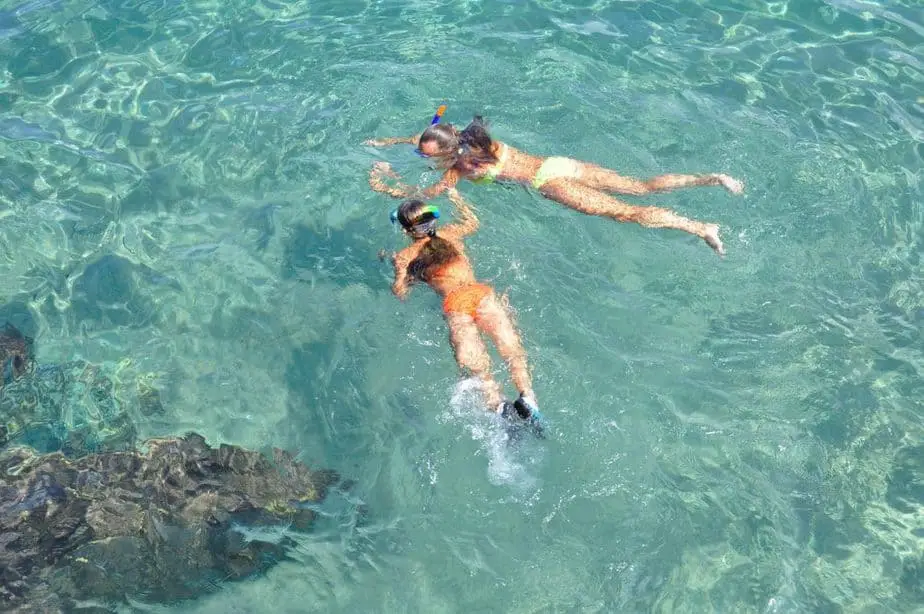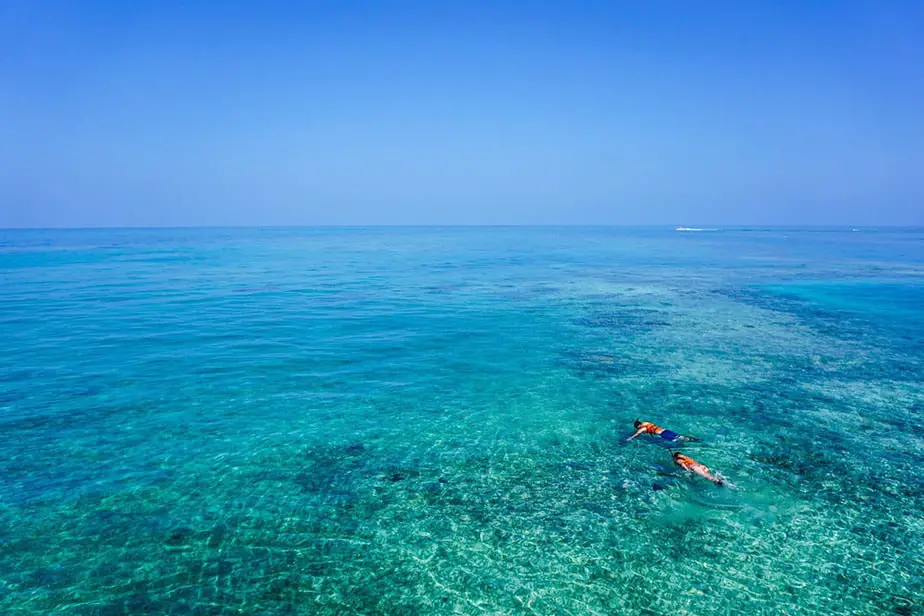If you’ve never snorkeled before, you might be wondering what kind of snorkeling equipment you need to bring. Thankfully, snorkeling is a pretty casual and leisurely hobby that doesn’t require much gear. Even what’s required is very cheap to buy or to rent. Personally, we recommend you bring your own gear to ensure that they fit you, are comfortable, and are hygienic.
In order to ensure your first snorkeling experience goes as smoothly as possible, we’ve compiled a comprehensive packing list for snorkelers to help make your trip as smooth and stress-free as possible.
Essential Snorkeling Gear to Wear
These are the bare minimum pieces of equipment you should have in order to snorkel.
Swimsuit
You don’t need any special swimsuits for snorkeling, just wear what you’d normally wear when you go to the swimming pool. While there definitely are swimsuits designed for snorkeling with 50 SPF to protect your skin from the sun, as a first time snorkeler let’s not complicate things until you’re sure you even like to snorkel.
Next, make sure your swimsuit isn’t too baggy, since it can get caught on stray pieces of coral or rocks. Best case scenario, you tear your swimsuit. Worst case, you can get seriously hurt by getting scraped by coral or rocks. Get a well-fitting swimsuit and stay safe!
Snorkel and Mask
It would be quite difficult to snorkel without a snorkel and a mask! What is a snorkel? It is a tube that lets wearers breathe while looking down into the water. You can sometimes find snorkels bundled with a mask.
Snorkeling masks let you see underwater and can even be used at deep depths if you decide to dive down. Snorkel and dive masks are the appropriate eye protection for underwater use, not swimming goggles! With them, you can see the beauty of the underwater creatures and landscape.
You can choose between wearing a snorkel and mask combination, or a full face mask which has the snorkel built-in. Furthermore, you can get a snorkel mask with a purge valve to deal with water leaking in. People who have facial hair should read this guide before buying a snorkel mask for beards and mustaches.
Sunscreen
As with any outdoor activity, you have to protect your skin from the sun’s harsh rays. Even if you have a swimsuit with SPF protection, a rash guard, or a full wetsuit, there will still be areas of exposed skin that you need to protect with sunscreen. It’s not fun to look like a tomato after a full day of snorkeling.
When buying sunscreen for snorkeling, you can’t just buy any old sunscreen; it has to be waterproof sunscreen so that it doesn’t wash off the moment you enter the water. We also recommend getting reef safe sunscreen which will not harm the reef and marine life. Apply sunscreen generously, and don’t forget to reapply it every two hours or even sooner just to be safe.
If you want to cut down on the amount of sunscreen to use, then consider getting a rash guard for snorkeling or a high SPF swimsuit to protect a large area of skin from the sun.
Recommended Snorkeling Gear
While you don’t need a lot of gear to start snorkeling, there are some equipment that we feel could drastically improve the snorkeling experience for you. Many professionals use these products to help them snorkel longer and provide extra protection. If you plan on snorkeling more in the future, consider investing into some of these products.
Rash Guard
Rash guards are relatively cheap and are something you can consider investing in to protect your torso. While they do not provide much in terms of insulation, the SPF and abrasion protection are great benefits. You can get short sleeved or long sleeved rash guards, as well as loose fitting or tight fitting ones.
Personally, we recommend long sleeved and tight fitting rash guards. The extra coverage means less sunscreen needs to be applied, and wearing a tight fitting one will reduce the chances of it snagging on coral or causing drag in the water.

Wetsuit
Wetsuits are the next level up from rash guards in terms of protection, but also price. Wetsuits have different thicknesses, from 3mm up to 7mm. They are made from neoprene, which is a material that is very good at insulating body heat. You can get full-body wetsuits or shorty wetsuits (your arms and legs are partially exposed).
If you are vacationing in a tropical climate such as in Hawaii, using a wetsuit for snorkeling may be a bit overkill, even a shorty wetsuit. However, if you plan on snorkeling in cold water, then wetsuits are a must. They provide everything rash guards do, but they keep you warm on top of that. Wetsuits are also slightly buoyant, so you snorkel without using as much energy to stay afloat. If the waters are cold enough, you can even wear a rash guard underneath a wetsuit.
Fins
Ever notice how a duck has webbed feet? This helps them swim faster, and for us humans we can simply wear snorkeling fins. Fins can help you propel yourself further and faster with each kick. They help you increase your strength and endurance, allowing you to snorkel longer. Fins are also naturally buoyant like wetsuits are, so staying afloat is much easier.
Before buying a pair of fins, you have to consider a few things. First, the length. There are short fins and long fins. Longs fins require more strength to use but can give you more power per kick. With short fins, you’ll have to move your feet more, but they feel almost like you’re not wearing fins at all.
You also have to consider closed heel or open feel fins. Open heel fins are more expensive because of how versatile they are. They have an adjustable strap by the heel which you can use to tighten or loosen the fit. It can therefore accommodate numerous foot sizes, including wide feet, and can be shared with family and friends. However, the strap tends to dig into your heels, and so many snorkelers have to wear dive socks or booties to protect against chafing.
On the other hand, closed heel fins are much cheaper, are not adjustable, and can be worn barefoot.
Optional Snorkeling Gear to Bring
Lastly, here are some things you don’t have to bring to snorkel, but they can provide extra warmth or protection for a much more enjoyable experience. If you have money to spare, consider the following:
Foot Protection
There are various types of foot protection that you can consider, such as neoprene socks and water shoes. We mentioned briefly in the fins section that the strap from open heeled fins can dig into your skin. To prevent this, you can wear neoprene water socks to prevent chafing. In addition, these socks provide insulation and will keep your feet warm.
You can also consider getting some water shoes. You won’t be wearing these shoes while you’re snorkeling, but you can wear them as you are walking to and from your snorkeling destinations. Along the shore you’ll encounter plenty of jagged rocks, seashells, and other debris. It can be difficult walking across it barefoot or with the fins on. Consider getting a pair of water shoes to make the trek much easier.
Personal Flotation Devices (PFDs)
If you are not confident in your swimming skills, or you want to take precautions to deal with emergencies in the water, then you should consider getting a snorkeling personal flotation device. The most obvious choices are life jackets, snorkel vests or flotation belts.
You’ll notice that most flotation devices are brightly-colored to ensure maximum visibility in the event you get separated from the group. Rescuers will be able to spot you more easily. Also, if you’re snorkeling in waters with boat traffic, this can help boats see you in the water.
Life jackets are the safest choice, however they may get in the way of snorkeling. The primary purpose of life jackets is to keep your head above water, while the point of snorkeling is to look down into the water. Furthermore, life jackets are bulky and difficult to swim in. But if safety is your number one priority, consider buying a life jacket.
Next, snorkel vests are much better suited for snorkeling. While they do not provide as much buoyancy as life jackets do, some snorkel vests can support over 150 pounds. There are two types of snorkel vests: horseshoe style and jacket style. The horseshoe style is worn over your head and secured in place with straps. Jacket style vests are worn like a jacket and zipped up. Both are effective, though jacket style vests are more expensive.
Snorkel vests can be inflated and deflated easily while in the water to allow you to control your experience. If you see something cool underwater and want to take a closer look, you can deflate the vest and dive down to check it out. Once you resurface, you can blow air into the air pouch using the plastic tube to inflate the vest again.
Another great flotation device for snorkeling are flotation belts. As the name suggests, they are belts worn around your waist that provide additional buoyancy. These belts can have their buoyancy adjusted, depending on the product, by removing some of the foam pads on the belt. Float belts may cause some drag in the water, and many snorkelers prefer wearing snorkel vests. However, in the end it is up to personal preference.
Swim Cap
Swim caps are useful for snorkelers with long hair that get in the way or who want to protect their scalp from sun exposure. Nobody wants to rub sunblock on top of their head, so a swim cap is an easy way to save some product and protect your head. Swim caps may also reduce drag while underwater, which can maximize your speed.
The Bottom Line
If you’re unsure of what to wear while snorkeling, hopefully this guide has helped you make sense of it. To get started with snorkeling, the bare minimum you need are the snorkel, mask, and your swimsuit. We highly recommend getting at least fins on top of this, and a snorkel vest if you want to stay safe in the water. And of course, always wear sunscreen, even if the sun isn’t out!
However, if you are planning on snorkeling once just to cross it off your bucket list, and don’t plan on going again, then consider renting the snorkeling gear. However, if you find snorkeling a fun and enjoyable hobby, we highly recommend investing in your own gear to ensure a good, comfortable fit and for hygienic reasons.


